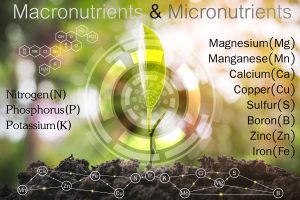 Manganese oxides are chemical compounds consisting of manganese and oxygen. They occur in nature and are mined there to be used in many products such as steel or batteries. The special thing about manganese oxides is that they occur in many oxidation states and can contain varying amounts of oxygen. The ability of manganese to exist in different oxidation states is used in batteries and in the chemical industry to carry out so-called redox processes and thus store energy or convert substances into other substances.
Manganese oxides are chemical compounds consisting of manganese and oxygen. They occur in nature and are mined there to be used in many products such as steel or batteries. The special thing about manganese oxides is that they occur in many oxidation states and can contain varying amounts of oxygen. The ability of manganese to exist in different oxidation states is used in batteries and in the chemical industry to carry out so-called redox processes and thus store energy or convert substances into other substances.
How can I come into contact with this material?
Because manganese and its oxides occur everywhere in nature, e.g. in rocks, they are ingested through food. Steel cutlery also contains manganese.
Manganese dioxide (MnO2) is used in alkaline batteries, so if you destroy a battery you could come into contact with it. Since batteries also contain other substances that are not beneficial to health, they should not be opened. This also applies to lithium-ion batteries, which contain not only manganese but also other substances that are harmful to health, such as cobalt or nickel. Manganese is used as a nanoscale material in solar cells, but here it is encapsulated and is thus not released during use.
Is there any risk from this material to humans and the environment?
The human body and most environmental organisms are used to taking up small amounts of manganese and manganese oxides with food. Humans need small amounts of manganese as an essential trace element for the body to function properly.
In common applications such as eating utensils, manganese and manganese oxides are firmly incorporated and are thus not released. They are therefore harmless to humans. High manganese concentrations can be harmful, so alkaline batteries or lithium-ion batteries should not be eaten.
Conclusion
Manganese oxides in low concentrations are harmless in the daily environment and in foods if handled with normal caution.
By the way…
Manganese oxides occur in many different colours, they are the multi-coloured ones of inorganic chemistry.
Properties and Applications
Manganese oxides are chemical compounds. They consist of manganese and, depending on the so-called oxidation state of the manganese (Mn), different amounts of oxygen (O). Manganese can occur in many different oxidation states. This is associated with different colours; manganese oxides occur in colours ranging from green (Mn(II)), to black (Mn(III)), to dark brown Mn (IV), to black-green (Mn(VI)) or dark purple (Mn(VII)). As oxygen-rich compounds, many manganese oxides provide a part of their oxygen in chemical reactions. Some manganese oxides decompose when heated. The oxygen-releasing ability of manganese oxides is used since many years in a large number of chemical reactions to oxidise other substances. Here it is not important whether the manganese oxides are nanoscale or not. Nanoparticles of manganese oxides are considerably more reactive than coarse-grained particles because of their significantly larger surface area.

Kitchen Knives ©andranik123_stock.adobe.com
Manganese oxides are used together with iron in the steel industry to produce manganese-iron alloys. These can regulate the carbon content of the iron through the manganese content and thus be used as intermediate products in steel production. Manganese is also a minor component of particularly hard and tough utility steel grade.
Manganese oxides and other manganese compounds have been one of the most important components in traditional battery technology for decades, because every "alkaline battery" contains relatively coarse-grained manganese(IV) oxide (MnO2) as cathode material. Anyone who has ever opened such a battery may remember the brown fingers: that is the manganese dioxide.

Batteries © Gudellaphoto_stock.adobe.com
Manganese oxides are currently discussed in connection with the energy storage, particularly for renewable energy. For example, as a storage material in lithium ion batteries (lithium-nickel-manganese-cobalt oxides), Mn(IV)/Mn(III) electrodes for supercapacitors but also as a nanoscale material for solar cells and for other, non-energy-related applications in sensors and medicine. The nanoscale material is used because of its large surface area making it very reactive.
In the past, potassium permanganate (chemical formula KMnO4, oxidation state of manganese: +7) dissolved in water was used as a disinfectant in medical applications. Today, in most cases iodine-containing solutions or hydrogen peroxide have replaced the potassium permanganate as reactive disinfectant solutions.
According to the information in the GESTIS Database, freshly produced MnO can self-ignite in the air or, in extreme cases, explode. The reason for this is that the small particles that are produced in a suitable synthesis method have not yet clumped together and are therefore particularly reactive.
Natual Occurrence and Production

Rhodochrosite, a manganese containing mineral © Vincent Lekabel-stock.adobe.com
The most important mineral group used for manganese extraction consist of manganese dioxide. Certain non-nanoscale minerals exists which are mined, e.g. Pyrolusite. All of them are manganese oxides and are dark brown in colour. A variety of other minerals contain manganese. One of the more important is manganite. It is found in the German Harz Mountains, among other places, but also in many other deposits around the world. It has the chemical formula MnO(OH), here manganese has the oxidation state +III. Many manganese minerals form beautiful crystals, which is why some are also used as gemstones, an example being rhodochrosite.
Nanoscale manganese oxides can be produced by reactive precipitation from aqueous manganese salt solutions, e.g. by dissolving potassium permanganate in water, heating it and decomposing it to manganese dioxide nanoparticles.
Bulk manganese oxides occur directly during the mining of manganese deposits, since manganese is usually found in nature as manganese oxide of various oxidation states.
Another potential source of manganese and manganese oxides are the manganese nodules, which are found on the seabed. Manganese nodules also consist of mixtures of various manganese oxides and other metal compounds. They are called concretions. Due to the expected severe damage to the marine ecosystem, experts are critical of planned economic mining of the nodules. In 2022, mining of manganese nodules is still prohibited.
Production
Manganese or manganese oxides are obtained in almost equal proportions either directly by mining or as so-called refined manganese as a by-product of the separation of other metals. In mining, South Africa, Australia and Gabon are the main mining countries, accounting for 58% of the manganese oxides extracted worldwide. Approximately 90% of the manganese oxides extracted are used for steel production, the remainder mainly as cathode material in batteries.
Manganese nodules, which in addition to manganese and nickel often also contain copper, cobalt, gold and silver, have not been mined to date because mining would involve a high degree of technical effort and expense. Manganese nodules are located in various areas on the seabed and their extraction would destroy a sensitive and largely unexplored ecosystem.

Manganese ore mining © Romeo - stock.adobe.com
Resource consumption during reprocessing
Around 70% of the ores processed in Europe are imported (as of 2020) and thus cause emissions through transport. No information is available on the consumption of natural resources such as forest or meadow areas for manganese extraction. There is also no detailed information on energy consumption during processing, but since manganese is usually present as an oxide and mixed with other substances, energy-intensive steps such as the reduction of oxidic manganese ores with coal are necessary to obtain metallic manganese (see also the Material Information).
Safety
Manganese is an essential element for all living things. Nevertheless, high concentrations can have a harmful effect. For example, inhalation of dust containing manganese can cause coughing, bronchitis and pneumonia in humans. This is particularly relevant for occupational health and safety, as many processes (e.g. welding) produce dusts containing manganese oxide. As with other dusts, the small, respirable particles are particularly critical here. Furthermore, manganese and its compounds can have a neurotoxic effect, i.e. damage the nerves. At high concentrations, manganism occurs, leading to Parkinson-like movement disorders. At lower concentrations, symptoms such as headaches, memory disorders, dizziness, weakness and fatigue appear first.
Emissions
In metallurgical melting processes for the production of manganese and manganese ferroalloys, carbon is used as a reducing agent. This reduces metal oxides to the metal, which means that oxygen is removed from the steel. This results in significant CO2 emissions of ~1.4 t CO2/t metal. In 2020, the EU metals industry accounted for 2.5% of total CO2 emissions in Europe. This included the production of 1.4 million t of manganese ferroalloys. Mining produces overburden, most of which is left in the vicinity of the extraction sites. Washing the ore also produces sludge with relatively high metal contents, which contaminates rivers in some mining regions. Noise from mining also has a negative impact on the lives of animals and the local population.
Social aspects
The corporate concentration of mining manganese oxides is classified as low, so there are relatively many companies mining manganese oxides. This is an advantage, as it means that not only a few companies benefit and monopolies are less likely. The weighted country risk for the countries of origin of the manganese oxides, into which the indicators of the World Bank are incorporated (Worldwide Governance Indicators), indicates a medium risk. This means that there is room for improvement in points such as political stability, voice and anti-corruption in some producing countries. For responsible metal production, due diligence in supply chains is becoming increasingly important in the EU (German Supply Chain Act: Lieferkettensorgfaltspflichtengesetz). The law requires the documentation or certification of social standards and occupational health and safety, but initially only for companies with more than 3,000 employees.
Disposal and recycling
The availability of manganese oxides is assessed differently, some sources assume an almost unlimited availability, while others assume an availability of another 40 - 60 years. As a result, the incentive for material recycling has been low to date. There are legal requirements for recycling rates for battery components, but since manganese oxides have so far only been used in batteries in small proportions, the new EU regulatory framework for batteries does not specify a recycling rate for this material. One third of the steel produced in Germany comes from steel scrap. However, due to the large number of different types of steel, it is unknown how much manganese oxides are recycled from steel.
How to make the manganese more sustainable?
Research is being carried out into more sustainable manganese production processes aimed at reducing CO2 emissions. No substitutions are currently expected in the main applications, as manganese oxides are readily available and many new mining sites can still be developed.
Further information:
- United States Geological Survey- National Minerals Information Center: Manganese Statistics and Information
- Horizon Europe project HAlMan: an integrated sustainable process to produce manganese (Mn) and Mn alloys
- EuRIC AISBL – Recycling: Bridging Circular Economy & Climate Policy (PDF)
- World Manganese Production (map)
Manganese is an essential trace element, which means that humans need it for the functioning of many enzymes. In particular, the redox potential of manganese should be emphasized, which is used in enzymes, for example, to render harmful oxygen radicals harmless, i.e. to counteract so-called oxidative stress. However, too high manganese concentrations can also be very harmful, especially for the nervous system.
Everyday contact
![]() Manganese is an important element and has great significance not only in the steel industry, but also biologically. It is one of the so-called “essential trace elements”, similar to iron, copper and zinc. It is important for us humans because, as a co-factor in enzymes, it ensures, for example, that oxygen radicals are neutralized, thus counteracting oxidative stress. This chemical reaction, which belongs to the redox reactions, is catalyzed by the manganese-containing enzyme “superoxide dismutase”, which in our cells is mostly located in the mitochondria, the power plants in our cells. As with other essential trace elements, it is important to avoid deficiencies, which can lead to loss of appetite or growth disorders. But an oversupply is also harmful, since manganese, like other metals, can have a toxic effect in high concentrations.
Manganese is an important element and has great significance not only in the steel industry, but also biologically. It is one of the so-called “essential trace elements”, similar to iron, copper and zinc. It is important for us humans because, as a co-factor in enzymes, it ensures, for example, that oxygen radicals are neutralized, thus counteracting oxidative stress. This chemical reaction, which belongs to the redox reactions, is catalyzed by the manganese-containing enzyme “superoxide dismutase”, which in our cells is mostly located in the mitochondria, the power plants in our cells. As with other essential trace elements, it is important to avoid deficiencies, which can lead to loss of appetite or growth disorders. But an oversupply is also harmful, since manganese, like other metals, can have a toxic effect in high concentrations.
The daily requirement of manganese for adult humans is about 1 - 5 milligrams and is met by foods such as grain products, certain berries, nuts, soybeans, and black tea.
In the daily handling of products containing manganese, an intake above the recommended level is very unlikely, because manganese is mostly contained solidly in alloys (steel), as an oxide in batteries or in photovoltaic systems, and the consumer does not come into direct contact with the material.
Situation at the workplace

In contrast to the everyday situation, certain workplaces are much more frequently exposed to manganese-containing dusts or particles. Exposure can occur during mining, transportation, and processing, or it can occur when working with, for example, manganese-containing electrodes during electric welding or machining of manganese-containing steels or other alloys. High exposure to manganese-containing dusts can lead to “manganism,” a disease of the nervous system similar to Parkinson’s syndrome. For this reason, potential exposure to manganese is regulated by law, and workplace exposure limits have been established. For the fraction of inhalable dusts (see also Granular biopersistent dust particles) 200 µg/m3 air are allowed in the ambient air of the workplace in Europe (EU Directive 2017/164). Here, it does not matter whether nanoparticles or larger particles are involved. The limit value applies regardless of size. In the event of possible manganese exposure, appropriate protective measures must be taken, such as wearing respiratory masks.
Products and consumer
Manganese and its oxides are firmly embedded in the products in which they are used. Whether in batteries or in photovoltaic systems, the consumer himself does not come into direct contact with it, so that under normal circumstances there is no exposure in daily use.
Humans need a certain daily intake of manganese through food, as it is used for important enzymatic processes in the body. However, an excess, especially if this happens permanently, is harmful to health, as manganese accumulates in the brain and can lead to neurological diseases. In the workplace, exposure is possible during processing into batteries or even photovoltaic systems, so limits and protective measures have been established to avoid excessive exposure to manganese and its oxides.
Further Information:
- EU Directive 2017/164: Indicative occupational exposure limit values: https://osha.europa.eu/en/legislation/directive/directive-2017164eu-indicative-occupational-exposure-limit-values ; download: https://eur-lex.europa.eu/legal-content/EN/TXT/PDF/?uri=CELEX:32017L0164&from=EN
- MAK and BAT Values (2021) doi: 10.34865/mbwl_2021_eng, https://series.publisso.de/sites/default/files/documents/series/mak/lmbv/Vol2021/Iss2/Doc002/mbwl_2021_eng.pdf
- The MAK‐Collection for Occupational Health and Safety: Manganese and its inorganic compounds [MAK Value Documentation, 2011], https://doi.org/10.1002/3527600418.mb743996e5014
- Michalke, B., and Fernsebner, K. (2014b). New insights into Manganese toxicity and speciation. J Trace Elem Med Biol 28, 106-116
Manganese oxides are very common on earth. They are released into air, water and soil. Due to their widespread distribution and versatile use, it is not possible to distinguish between technically produced manganese oxides and natural particles containing manganese oxides.
General release
There are no studies on the release of manganese oxide particles (as of March 2022), but many release processes are known for other manganese compounds, which can be of both natural and human origin (e.g. in the combustion of fossil fuels or ore processing). Due to the frequent occurrence and versatile use of manganese compounds, the release takes place in air, water and soil. Thus, there is a high, natural background level of manganese compounds.
At present, it is not possible to distinguish engineered manganese oxide nanoparticles from naturally occurring manganese oxide nanoparticles and to measure the corresponding concentration of engineered nanoparticles. In order to be able to make an estimate of the released quantities, the calculation of the environmental concentrations is possible by means of various computer models taking into account the various release scenarios (see Cross Cutting text - Estimating the occurrence of nanomaterials in the environment).
Released amounts
There are no data on the release of manganese oxide nanoparticles, but there are averaged values for release into the air for manganese compounds. Studies conducted in different countries in the 1970s were able to measure concentrations of 10 - 30 ng/m3 in rural areas, while concentrations in cities were higher and ranged from 10 - 70 ng/m3 .
In the environment, high, natural background levels of various manganese compounds can be found. It is therefore not possible to distinguish engineered manganese oxide particles from natural particles. This means that it is not possible to accurately determine the amount of release from technical products and processes.
Further informationen
- World Health Organization. Regional Office for Europe. (2000). Air quality guidelines for Europe, 2nd ed.. World Health Organization. Regional Office for Europe. https://apps.who.int/iris/handle/10665/107335
Humans absorb manganese with their food. Of this, only about 10% is absorbed via the small intestine and transported into the blood and internal organs; the rest is excreted. In the lungs, manganese from dust particles can also enter the blood via the air-blood barrier (see Nanoparticles and the lung). At high concentrations, manganese can reach nerve cells in the brain across the blood-brain barrier, where it can cause lasting damage. The different modifications and oxidation states as well as the different solubility of the manganese species play an important role.
Uptake via the lung
For manganese, unintentional uptake via the respiratory tract actually seems to be the most relevant route for potential poisoning. Especially at polluted workplaces, good precautions must therefore be taken and appropriate mitigation measures should be applied to avoid uptake via the lungs. Here, above all, the direct route via the olfactory bulb (scientifically bulbus olfactorius, see Nanoparticles and the olfactory mucous membrane) also plays an important role, since the manganese can be transported directly from the nose into the brain and thus also bypasses the blood-brain barrier . Uptake via the olfactory mucosa is probably the common one not only for manganese salts but also for particulates and leads to brain exposure, which helps explain the neurotoxic effect. The necessary supply of manganese in the body tends not to be replenished via this route, but rather the manganese contained in food is resorted to . Nevertheless, manganese dissolved in the blood can cross the blood-brain barrier as an ion by means of certain transport systems and enter the brain . A small, constant amount of manganese is also required by the cells there.
Uptake via the skin
An uptake of manganese via the skin is not known to date, neither for salts nor particles containing manganese or manganese oxide, therefore this uptake pathway rather does not play a role for human exposure.
Uptake via the gastro-intestinal tract
 The human body replenishes its reservoir for manganese through food, i.e. the manganese is transported from the food in the small intestine into the body and distributed via the liver to other important organs that require the manganese for the function of certain enzymes. The daily intake ranges from 1 to 5 mg for an adult. It should be kept in mind that only about 10 % of the manganese contained in food is absorbed. The vast majority of 90 % is directly excreted . However, there is enough manganese in the diet so that no deficiency occurs in European countries. The manganese absorbed via the small intestine is not transported to the brain.
The human body replenishes its reservoir for manganese through food, i.e. the manganese is transported from the food in the small intestine into the body and distributed via the liver to other important organs that require the manganese for the function of certain enzymes. The daily intake ranges from 1 to 5 mg for an adult. It should be kept in mind that only about 10 % of the manganese contained in food is absorbed. The vast majority of 90 % is directly excreted . However, there is enough manganese in the diet so that no deficiency occurs in European countries. The manganese absorbed via the small intestine is not transported to the brain.
Uptake via medical applications
Recently, several groups have been working to explore manganese oxides and complexes for medical purposes. An extensive review article highlights many of the ways in which manganese in its various oxidation states, or even various manganese complexes, are suitable for either aiding diagnosis in imaging techniques or even being used in therapies for disease . If the manganese is incorporated as an ion into a larger molecular complex and then packaged into polymer nanocapsules, it can kill cancer cells and could be used as a tumor drug. However, these laboratory experiments have yet to be confirmed in clinical trials . Also in clinical testing are iron-manganese alloys for stents or bone screws, for example . The advantage of such alloys would be that the materials dissolve slowly in the biological environment and no further surgery is required to remove the foreign material. The dissolution is so slow that there can be no harmful side effects. In any case, these mentioned applications would contribute to human exposure to manganese. But the amounts involved would be within tolerable limits, and short-term excesses could be quickly excreted. In the case of manganese, this excretion takes place via the liver and bile (hepatobiliary excretion pathway), i.e. the manganese is transported from the liver into the bile ducts, from there it passes with the bile into the intestine and is then excreted in the stool .
Humans need manganese for their metabolism and therefore absorb manganese from food. Manganese can be transported everywhere in the body, even across the blood-brain barrier, and therefore the amount absorbed must not be too large, otherwise it becomes toxic. Inhalation should be avoided, as manganese can enter the brain directly via the olfactory mucosa both as a salt or oxide and in particles, and since it is neurotoxic and leads to Parkinson’s-like symptoms, the uptake via the lungs should be prevented. Manganese is also being considered as a possible drug, but these applications are still in the laboratory phase.
The manganese contained in manganese oxides is an essential trace element for many organisms. Ingested in low concentrations it is harmless, but in high concentrations it can be toxic.
Uptake in environmental organisms
Water fleas absorb manganese oxide particles. In these laboratory experiments, a 7-500-fold increased concentration of manganese oxide nanoparticles (Mn2O3) in water fleas was measured compared to untreated water fleas. A transfer within the food chain and long-term effects can therefore not be excluded .
Mosses also quickly absorb manganese oxide nanoparticles (Mn3O4) and store them .
Toxicity
In plants, low concentrations of manganese oxide nanoparticles (Mn2O3) show a stimulating effect on growth. In detail, they produce more green leaf dye, more shoots and show increased activity of enzymes containing manganese. Only at very high concentrations of manganese oxide do negative effects occur, such as reduced roots or reduction of root weight and damage to the cell surface .
A toxic effect of high concentrations of manganese oxide nanoparticles (Mn2O3) occurs in bacteria. In the case of the bacterium E. coli, the toxic effect manifests itself in a concentration-dependent inhibition of growth. As fluorescence stains prove, manganese oxide nanoparticles are likely to cause partial destruction of the cell envelope .
In high concentrations (100 μg/ml), nanowires made of manganese oxide (Mn2O3) inhibit the growth of bacteria. Microscopic observation has shown that the nanoparticles have accumulated, which also resulted in the destruction of the cell. .
The important group of nitrogen binding bacteria grows more slowly with increasing concentrations of manganese oxide nanoparticles (Mn2O3). Decreased gene activity was also noted. Interestingly, this effect occurs only in high oxygen environments, suggesting that oxygen affects the action of manganese oxide .
Like bacteria, yeasts are inhibited in their growth by manganese oxide nanoparticles (Mn2O3) (from 100 to 1000 mg/L). Here, too, damage to the cell envelope can be found. Nanoparticles of titanium dioxide, which were used as a reference, show no influence on growth .
Shrimps, like plants, show improved growth, higher activity of digestive enzymes and increased muscle building after feeding with manganese oxide nanoparticles (Mn3O4) .
A protective effect of manganese oxide nanoparticles (MnO2 and Mn3O4) was found in mouse cells. Hydrogen peroxide, a substance that can severely damage the cells, is converted into harmless oxygen by the manganese oxide nanoparticles. The manganese oxide acts as a catalyst. This protective, catalytic function of manganese oxide nanoparticles could be used in inflammatory reactions that are often associated with oxidation processes .
Algae can produce manganese oxide nanoparticles (Mn2O3) themselves and store them in their cells. The catalytic effect of the nanoparticles causes a degradation of pollutants, e.g. bisphenol A .
In addition to algae, bacteria also have the ability to independently synthesize manganese oxide nanoparticles (Mn2O3) .
Nanoscale manganese oxides as mineral additives in feeds have no adverse effects on chicken development. The use of nanoscale manganese oxides is preferred because chicken can utilize it better than larger particles .
Summary ROS
Very high manganese oxide particle (Mn2O3) concentrations can lead to an increased release of ROS in living organisms. This effect is manifested in water fleas, bacteria and mosses .
Assessment of the effects in environmental organisms
Manganese oxide (Mn2O3) compounds promote growth in low doses, but too high concentrations lead to toxic effects (e.B. damage to the cell envelope or development of ROS). The positive effect is due to the essential importance of manganese as an important trace substance, while the negative effect is explained by the formation of ROS, which only occurs at high concentrations of manganese oxide nanoparticles .
Manganese oxide nanoparticles promote growth and health in low concentrations. High concentrations cause oxidative stress/ROS in cells and damage occurs.
Manganese is an essential trace element. It must be ingested daily in low amounts and is active as a co-factor or central atom in enzymes that fight oxidative stress. However, too much manganese can cause brain damage similar to Parkinson’s symptoms.
Distribution and effects in the body
Manganese is absorbed in its compounds, mostly as oxides, through food. About 10 % of the manganese contained in the diet enters the liver via the small intestine and is then distributed to the organs that require it . These processes of absorption and distribution are highly regulated, so there is no risk of ingesting too much manganese via this route of absorption. The situation is different when exposure occurs via the lungs and larger amounts are inhaled. Manganese-containing dusts, which are produced at the workplace for example and can be inhaled, also lead to exposure of the deep parts of the lungs. There, manganese can be absorbed very well. In addition, particles containing manganese also reach the olfactory bulb, an anterior part of the brain, directly via the olfactory mucosa in the nose (see Nanoparticles and the olfactory mucous membrane). This direct route into the brain bypasses the blood-brain barrier and leads to high exposure of the forebrain and subsequently the entire brain . Since transport into the brain is very rapid, prolonged exposure to manganese will inevitably lead to its accumulation in the brain . There, an overdose of manganese causes an opposite effect to the desired combating of oxidative stress: too much manganese increases oxidative stress! This permanent increase in the concentration of oxygen radicals causes nerve damage, which leads to typical effects; rapid fatigability, sleep disturbances, muscle pain and hypertonia, mask-like face, gait changes, coordination disorders, hallucinations and mental irritability are among the symptoms .
Moreover, the effects are almost independent of the speciation of the manganese. For manganese (II,III) oxide (Mn3O4), an inflammatory effect was described after exposure of mice via the lungs at relatively low concentrations and the same effect was observed after administration of the same amount of manganese (III) oxide (Mn2O3) . In rats, transport to the brain and neuronal effects were also demonstrated after exposure of the lungs to manganese dioxide (MnO2), but at a much higher concentration . All these experiments were performed with nanoparticulate manganese oxides.
For the manganese dioxide (MnO2), it was also shown that after oral intake of high amounts of the manganese dioxide, there was an increased transport to the liver and from there the distribution could also be detected to the brain, which led to significant effects in the treated rats . However, the authors of the studies clearly emphasized that these concentrations do not reflect reality, as this does not correspond to the daily intake in humans.
Uptake and effects in cells
Several in vitro studies have investigated the biochemical processes in cells after manganese oxide treatments, and different oxides of manganese were also used. Manganese dioxide (MnO2) triggered oxidative stress at low concentrations compared to other metal oxides in nanoform . In in vitro experiments, human neurons formed reactive oxygen radicals and increased their antioxidant capacity. Nevertheless, the nerve cells were damaged and began to die.
Manganese (III) oxide (Mn2O3) did have varying effects depending on the cell types, but effects were more limited to lung epithelial cells. Thus, phagocytes of the lung were little affected by the addition of this manganese oxide and the authors of the study were surprised that the effect was so small . For the epithelial cells of the lung, the situation was more comparable to the results obtained in animal experiments, the manganese (III) oxide was cytotoxic and induced oxidative stress in the cells . Epithelial cells but also human neurons also reacted with apoptosis in vitro. In turn, Mn2O3 had a much smaller effect on very specific immune cells of the lung, so-called dendritic cells, and on the cells in a 3D lung model. After treatment with 70 nm manganese (III) oxide particles, only certain proteins on the plasma membrane of the dendritic cells increased, otherwise no harmful effects were observed in the 3D model .
The third variant of manganese oxides studied, Mn3O4 (manganese (II,III) oxide), also leads to a corresponding reaction in lung epithelial cells due to oxidative stress. A systematic study dealt with the alteration of an important electronic state of the compound by the addition of other elements to the nanoparticles. The toxic effect and the triggering of oxidative stress in both lung epithelial cells and macrophages depended directly on a change in this property , which was cited as an example for the fabrication of “safe-by-design” particles (compare Spotlights March 2022 and Spotlight November 2021). However, the pure Mn3O4 had a clear effect on epithelial cells of the lung and the typical effects such as oxidative stress, cell death, etc. were also observed here . In this comparison, the nanoparticulate manganese oxide was significantly better taken up by the cells than dissolved manganese salts.
Due to its redox potential, manganese has effects especially in connection with reactive oxygen species. In low amounts incorporated in certain enzymes in the body manganese positively counteracts oxidative stress. However, increased concentrations of manganese have exactly the opposite effect: too much of it in the body increases oxidative stress, which can have serious consequences, especially in nerve cells of the brain. The cells partially die and manganism occurs, which are Parkinson’s-like symptoms.
Manganese oxides are found everywhere in the environment due to their natural occurrence. The majority is not present as nanoparticles. It is difficult to distinguish between engineered and natural particles.
Transport
Natural processes such as wind erosion, but also agricultural cultivation of fields, construction or the burning of fossil fuels lead to the particle release of manganese oxides into the atmosphere
Manganese oxide compounds are ubiquitous in the environment and are difficult to distinguish from technically produced or released by human activities manganese oxide compounds in terms of their distribution.
Further informationen
- World Health Organization. Regional Office for Europe. (2000). Air quality guidelines for Europe, 2nd ed.. World Health Organization. Regional Office for Europe. https://apps.who.int/iris/handle/10665/107335
 >
>